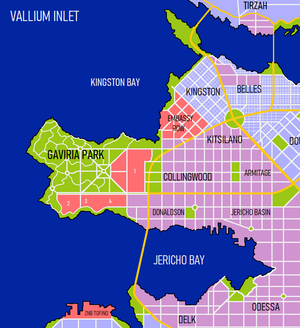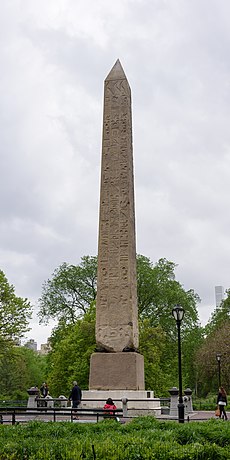Gaviria Park: Difference between revisions
No edit summary |
|||
| Line 63: | Line 63: | ||
===Sculptures and statues=== | ===Sculptures and statues=== | ||
====Animals==== | ====Animals==== | ||
*The '''Normark Wolverine''' is a statue gifted by the government of [[Greater Normark]] in 1956 as a symbol of friendship between the two countries and in honor of their respective soldiers that died during the [[World War (Iearth)|World War]]. It portrays a wolverine carrying an axe in its mouth. The wolverine is the national animal of Normark, and the axe is the Normarkian symbol for honor and camaraderie. It was sculptured by Edmund Krantz, who fled from [[Versenia]] to Normark during the war. | |||
====Artists==== | ====Artists==== | ||
====Historical figures==== | ====Historical figures==== | ||
Revision as of 22:40, 24 June 2023
| Gaviria Park | |
|---|---|
| Gaviria National and Memorial | |
 A pedestrian path along the Tofino Seawall | |
| Type | Cultural |
| Location | Tofino, Zamastan |
| Current use | Urban Park |
| Visitors | 23.9 million (in 2020) |
| Governing body | Secretary of the Interior |
| Owner | City of Tofino |

Gaviria Park is a landscaped urban park in the capital city of Tofino, Zamastan. The park is located on a peninsula jutting into Horseshoe Bay, directly west of the Congressional Hall grounds, the Zian Presidential Mansion, and the neighborhoods Embassy Row, Collingwood, and Donaldson. The term Gaviria Park commonly includes areas that are also officially part of neighboring Congressional Park to the east, as it continues a uniformed park display alongside unique and iconic architectural displays such as Congressional Hall and the Presidential Mansion.
Previously named Capital Park, it was renamed after President Marvin Gaviria in 1974. The park contains and borders a number of museums, art galleries, cultural institutions, and various memorials, sculptures, and statues. Much of the park remains as densely forested as it was in the late 1800s, with about a half million trees, some of which stand as tall as 76 metres (249 ft) and are hundreds of years old. Thousands of trees were lost (and many replanted) after three major windstorms that took place in the past 100 years. Significant effort was put into constructing the near three century old Tofino Seawall, which can draw thousands of people to the park in the summer. The park also features forest trails, beaches, lakes, children's play areas, and the Tofino Zoo and Aquarium, among many other attractions. The park receives approximately 24 million visitors each year.
History
Landmarks, museums, and other features
National Monuments and Memorials
- Gaviria Monument
- Hapson Memorial
- Independence Monument
- World War Memorial
- Paraboca War Monument
- Veterans Memorial
- Tiller Monument
- Thomas Pétion Monument
- William Castovia Memorial
- Elias Blanco Memorial
- Women's Rights Pioneers Monument
- Memorial for the Vulkaria Wars
- Taures Memorial
- Kordia Memorial
- Lorrie Memorial
Sculptures and statues
Animals
- The Normark Wolverine is a statue gifted by the government of Greater Normark in 1956 as a symbol of friendship between the two countries and in honor of their respective soldiers that died during the World War. It portrays a wolverine carrying an axe in its mouth. The wolverine is the national animal of Normark, and the axe is the Normarkian symbol for honor and camaraderie. It was sculptured by Edmund Krantz, who fled from Versenia to Normark during the war.
Artists
Historical figures
- Mohammad Mah Palavi's statue was erected in 1965 by the commemoration of Emmirian and Zamastanian ties. Often considered to be the 'father of modern Emmiria', the Mah Palavi Monument is an equestrian statue holding over his head a ceremonial crossed sword.
- The Percy Armillio Monument was presented to the park in 1826, commemorating the 100th anniversary of his crew's fateful mutiny.
- In 1916, the Almirian Gamor Monument was donated to the park by the government of Quetana. The sculpture depicts the famous explorer standing with outstretched arms, looking towards the heavens in gratitude for his successful voyages to Euronia, Ausiana, and Antartique.
- The Wolterink Monument was gifted to the park by the Beatavician government in 1962. The Prime Minister of Beatavic was instrumental in forming diplomatic relations with Zamastan following the World War.
- The Soares Monument commemorates Rufino Soares, the 7th President of Quetana who was instrumental in allied leadership during the World War. The Quetanan government presented the bronze statue standing on a high granite plinth in 1997.
- A sculpture of Albrecht Neumann gifted by the Besmenian government sits at the south end of the park along Swan Lake, gifted in 1984 for the 30th annivesary of the end of the World War.
Writers and poets
Museums
Trails and walkways

The Tofino Seawall is popular for walking, running, cycling, inline skating, and even fishing (with a licence). There are two paths, one for skaters and cyclists and the other for pedestrians. The lane for cyclists and skaters goes one-way in a counterclockwise loop. Walking the entire loop around Gaviria Park takes about two-three hours, while biking it takes about one hour. There are also more than 27 kilometres (17 mi) of forest trails inside the park. Forest trails are patrolled by members of the Tofino Police Department on horseback. The Mounted Unit's youth outreach includes offering guided tours of the stables and the ‘Collector’s Trading Card Program,’ which encourages children of all ages to approach a constable on horseback and request a card.

Swan Lake is a restful space nestled among the trees. The lake is almost completely covered with water lilies and home to beavers, fish, and water birds. As of 1997, its surface area was just short of 4 hectares (10 acres), but the lake is slowly shrinking in size. One of Tofino's few remaining free-flowing streams, Heston Creek, joins Swan Lake to the Olympic Ocean and is one of two streams in Tofino where salmon still return to spawn each year. Alberts Lagoon, the captive 17-hectare (41-acre) freshwater lake near the Killian Street entrance to the park, is a nesting ground to many bird species, such as geese, and ducks.
The Tofino Zoo and Aquarium is the largest in Zamastan and houses a collection of marine life that includes dolphins, belugas, sea lions, harbour seals, and sea otters. In total, there are approximately 600 species of fish, 30,000 invertebrates, 156 species of amphibians and reptiles, and around 160 mammals and birds. The aquarium is also home to a 4D theatre.
The oldest manmade landmark in the park is a 2800 year-old red granite obelisk from Emmiria, gifted to President Elias Blanco during his 1932 visit to Hazarabad. The Nine O’Clock Gun is a 1576 naval cannon located near Mackton Pointas, which was fired for the first time in 1828, a tradition that has continued daily for more than 100 years. The cannon was originally detonated with a stick of dynamite, but is now activated automatically with an electronic trigger.
Gaviria Park also has playgrounds, sandy beaches, gardens, tennis courts, an 18-hole pitch and putt golf course, a seaside swimming pool, a water spray park, and Neville Oval, which is used for track sports, rugby, and cricket.
The park has four restaurants. Charlie's is a famous indoor restaurant known for being frequented by celebrities and diplomats visiting Tofino. Ocean View is a shoreline pub and restaurant, known for burgers and beverages.

